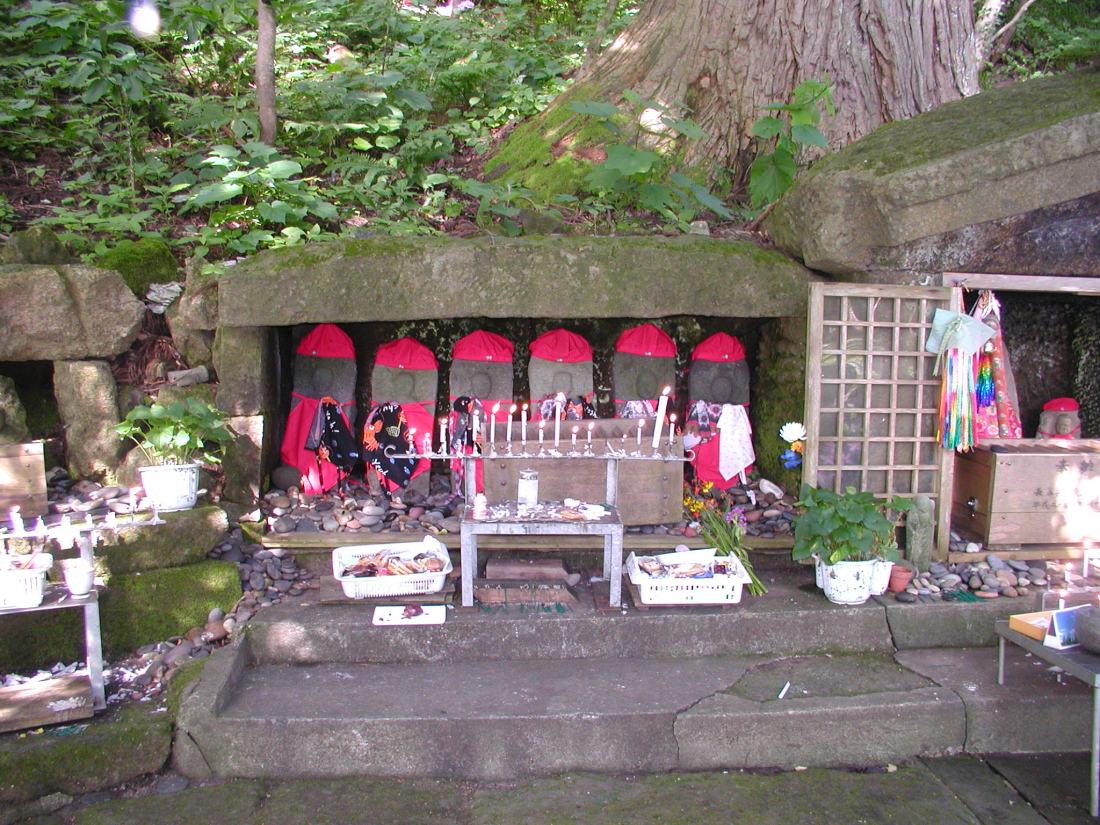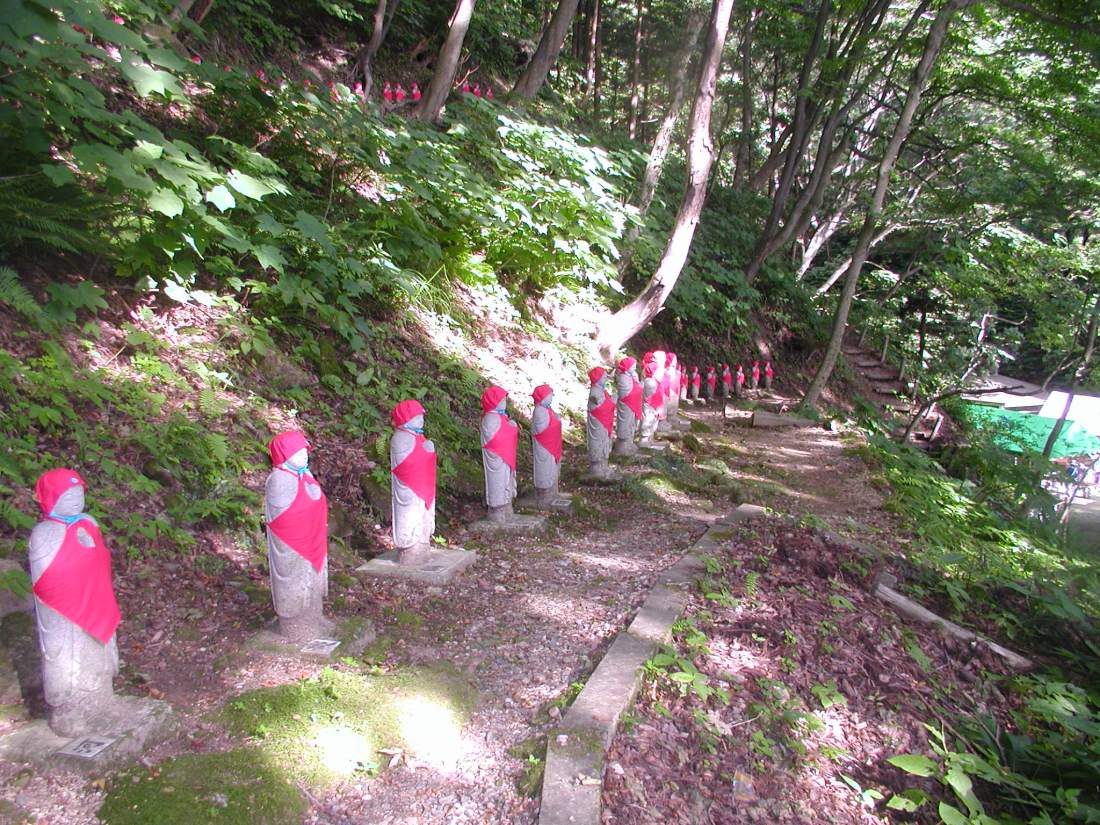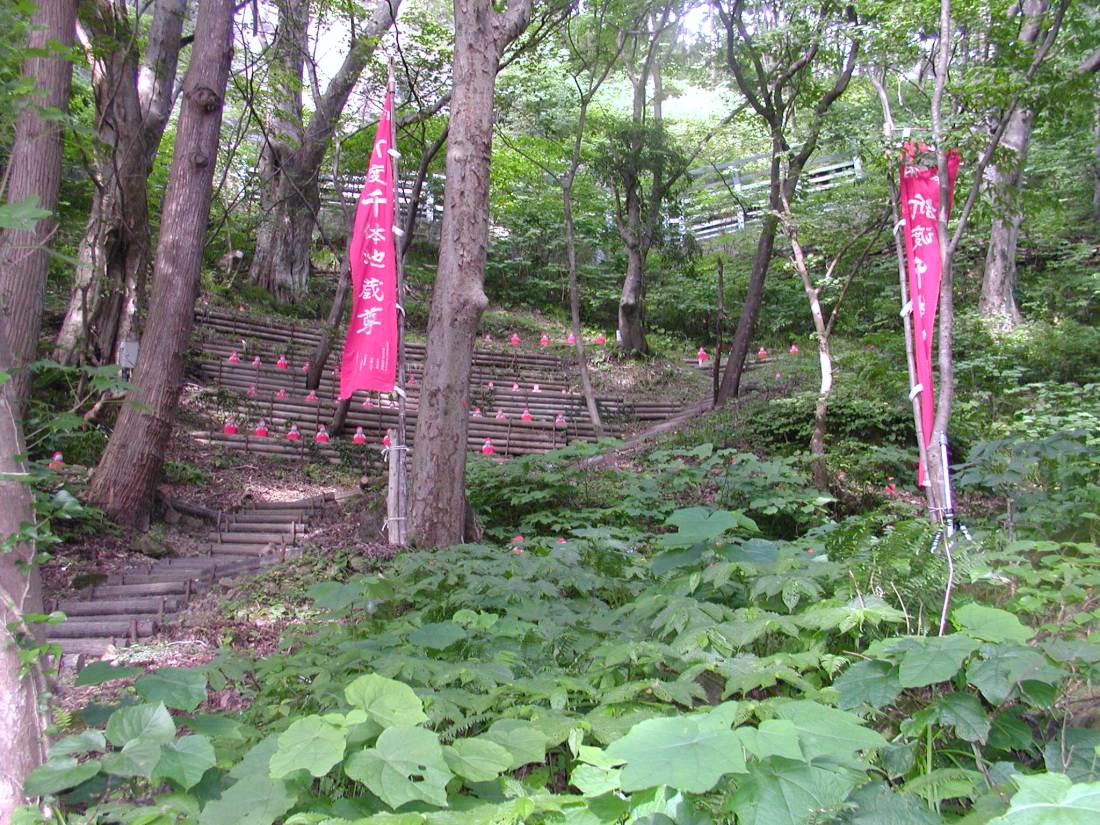六地蔵光輝く夏木立
Roku Jizō hikari kagayaku natsu kodachi
Six Jizō Statues
brighten in the light ―
summer grove
地蔵尊立ちて微笑む夏木立
Jizō son tachi te hohoemu natsu kodachi
Jizō Statues
stand smiling ―
summer grove
地蔵尊再び出会ふ夏木立
Jizō son futatabi deau natsu kodachi
Jizō Statues
have a reunion ―
summer grove
These haiku were written when we attended the annual Jizō festival held at One Thousand Jizō (千体地蔵, Sentai Jizō) or Oriwatari Jizōson (折渡地蔵尊) , located in Oriwatari, Ouchi, Yurihonjo.
1012 statues stand along a trail up a hill side in Oriwatari.
We visited there on the eve of the festival, on July 23, 2011, taking some photos.
When were One Thousand Jizō built there?
Why were One Thousand Jizō built there?
Members of Akita prefecture (秋田県) ajet community took up the history of One Thousand Jizō in their homepage, in which they tell us about it through English translation of the article taken from the Akita Sakigake newspaper(秋田魁新聞); 18th May 2009 as follows:.
Mourn those who died in battle, and in the line of duty.
“For a world without war”, “As a memorial for the victims of a cave-in.” In Iwayafumoto of Yurihonjo along the Oriwataritougei walkway, the 16cm tall 1012 Jizō are lined up in order. The Jizō are privately owned memorial Buddhas. On July 24th contributors from inside and outside the prefecture attend the annual Jizō festival that is held, and every year many worshippers come to visit.
With the “Oriwatari Longevity Jizō” (Oriwatari Enmei Jizō) donated two hundred years ago by the founder of Choukoku temple in the city of Akata, Koreyama Zenji, as the principle object of worship (本尊), the Thousand Jizō line the surrounding 4 kilometers (of the hill) in rows.
Taking over the ambition of a monk who saw the sacred construction sight in a dream, volunteers from the town solicited donations of “One person, one Buddha,” and from 1989 it took them two years to build (the temple). According to representative of the Oriwatari Thousand Jizo support team, Mr. Takahashi Kiichiro (82), during its initial foundation there were a thousand and one statues. Damaged Jizō were replaced given the opportunity, and now there are 2012 statues.
Beneath the two statues at the top of the mountain, damaged roofing tile and other things from when the atomic bomb was dropped in Hiroshima are buried. Mr. Takahashi, who had participated in survey research on special weapons fighter planes at the Naval/Air Force Technical Workshop (Kanagawa Prefecture, Yokosuka City) during World War II, stated “Young people of the same generation as myself got into special attack planes and one after another gave up their lives. This is also to atone for that.” A stone monument was built between (the two statues), and marked with a symbol of peace.
Directly beneath Oriwataritougei, there is also a memorial Buddha marking the location of the Oriwatari Tunnel (Uetsu line) where workers were killed during its construction. According to the Ouchi town records book “Oriwataritougei”, many workers were killed in a cave-in during the tunnel’s construction, which began in 1942 . Before anyone knew it, the workers’ breath was cut short in the darkness, and the town’s women whose hearts suffered donated (the Buddha). Embedded (in the ground) beneath each Jizō is a pedestal, each displaying a different kanji character. The kanji is taken from collections of old Chinese poems such as “Senjimon” (Senjimon is a series of long poems that were written to teach children Chinese characters. The poems contain 1000 different characters). They have become a staple of visits to the temple.
Here is an original Japanese article.
戦没者、殉職者を弔う
「戦争のない世の中を」「落盤事故の犠牲者供養に」‐。由利本荘市岩谷麓にある折渡峠の遊歩道沿いに、高さ六十(センチ)の地蔵千十二体が整然と並ぶ。地蔵は個人の供養仏。県内外に寄進者がおり、七月二十四日の地蔵盆に合わせて行われる例祭には、毎年多くの参拝者が訪れる。
千体地蔵は、同市赤田の長谷寺の開祖・是山禅師が約二百年前に寄進したとされる「折渡延命地蔵」を本尊とし、その周辺約四キロにずらりと列をなしている。山岳信仰の拠点構築を夢見た禅師の志を受け継ごうと、地元有志が「一人一仏」の寄進を募り一九八九年から二年掛けて建立した。折渡千体地蔵護持会代表の高橋喜一郎さん(八二)によると、建立当初は千一体。破損した地蔵の交換を機に追加するなどし、現在は千十二体。
山頂にある二体の下には、広島市に原爆が投下された際に破損した瓦などが埋まっている。第二次世界大戦中、海軍航空技術廠(廠:しょう)(神奈川県横須賀市)で特殊攻撃機の調査研究に携わった高橋さんは「自分と同世代の若者が特攻機に乗り込み、次々に命を落としていった。罪滅ぼしのためでもある」と話す。二体の間に石碑を建て、平和を願うシンボルとした。
折渡峠の真下に位置する折渡トンネル〈羽越線)の建設工事中に殉職した作業員の供養仏もある。旧大内町発行の冊子「折渡峠」によると、一七年着工の同トンネル工事では落盤事故で多数の犠牲者が出た。誰にもみとられず暗闇で息を引き取った作業員がいたことに心を痛めた地元女性らが寄進した。それぞれの地蔵の台座には、異なる漢字一字のパネルが埋め込まれている。漢字は中国の四言古詩「干字文」などの文字を記した。参拝時の目印となっている。
Article courtesy; as per original copyright:
http://www.akitajet.com/wiki/index.php?title=One_Thousand_Jizo
Lastly, let me post the fourth part of RO KU Magazine – Japan, between suffering and hope dedicated to the disaster from Fukushima.
Courtesy of Mr. Corneliu Traian Atanasiu, editor of ROMANIAN KUKAI, here is a pdf file of the magazine.
侘 寂
WABI SABI
printre ruine –
într-o stampă niponă
ning flori de cireş
among ruins –
in a Japanese stamp
cherry blossoms
廃墟の中 ―
日本の切手に
桜の花
zi de doliu –
copiii trimit pe apă
bărci de hârtie
day of mourning –
the children put off water
paper boats
喪中の日 ―
子供たちが水をかけそこねる
紙製の船に
veşti din Akita –
drumurile lui Bashō
numai ruine
news from Akita –
Basho’s roads
only ruins
秋田からのニュース ―
芭蕉の道
ただ廃墟
negură deasă –
în năvoadele rupte
PET-uri şi-un bocanc
dense fog –
the torn nets
a PET-and a brogue
濃霧 ―
ちぎれた巣
ペットとブローグ
după tsunami,
doar zborul albatroşilor
în Fukushima
after tsunami,
only the albatrosses’ flight
in Fukushima
津波の後 ―
ただアホウドリの飛翔のみ
福島では
case-n fărâme –
greutatea liniştii
acolo aici
crushed houses –
the weight of spring silence
there here
壊滅した家々 ―
春の沈黙の重さ
そこここに
printre ruine –
limba minutarului
sprijină cuibul
among ruins –
the minute hand
leans the nest
廃墟の中 ―
とてもか細い手
巣にもたせかかる
după explozie –
acelaşi soare încălzind
o altă lume
after explosion –
the same sun warming
another world
爆発の後 ―
同じ太陽が暖めている
別の世界を
The next posting ‘3.11 Haiku from the Romanian Haiku Group (5)’ appears on September 3.
― Hidenori Hiruta (member of HIA)



Thanks for the interesting story about the Jizo statues.
I like Jizo very much and have some in my garden.
Here is more about this deity
http://darumamuseumgallery.blogspot.com/2007/04/jizo-bosatsu.html
.